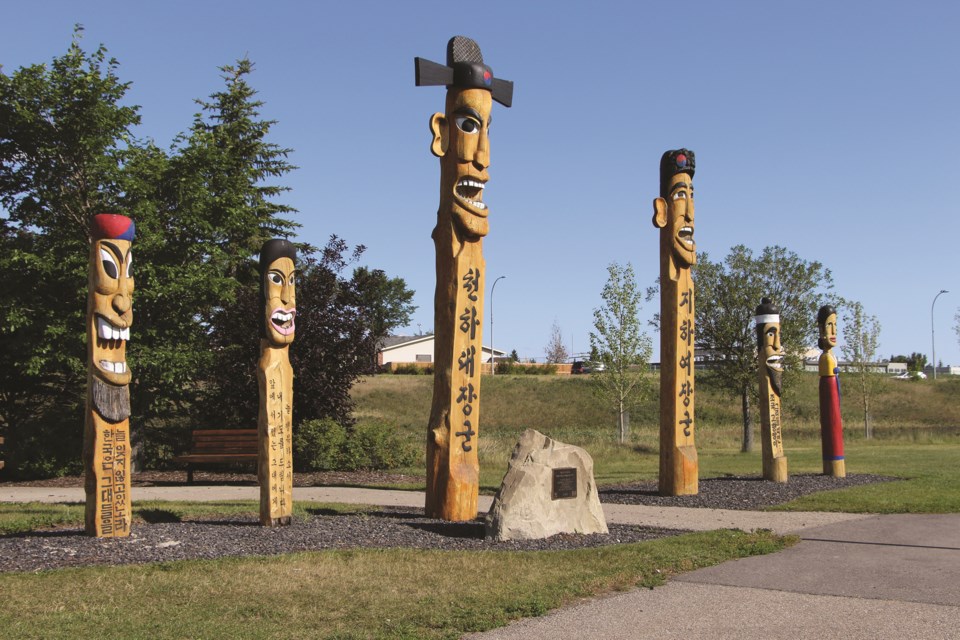Talk about some rotten luck.
The City of Airdrie is removing the iconic Gwacheon Park totem poles to preserve the site’s safety, according to the municipality.
The six totem poles, located in Nose Creek Regional Park across from Nose Creek Pond, were gifted to the City in 2007 to commemorate a sister-city relationship between Gwacheon, South Korea and Airdrie – a tie that began 10 years earlier.
While the sister city relationship has been inactive for many years and is now only considered ceremonial, the totem poles remind passersby of a time when the two cities, more than 8,000 kilometres apart, shared a special bond of friendship.
According to Michael McAllister, a community developer with the City, one of the smaller of the six totem poles fell over last summer, leading the municipality to investigate the structural integrity of the remaining five poles.
“Our parks department arrived on scene and immediately removed the totem pole from the site for its safety and the general public’s safety,” he said of the incident.
“After which, an engineering report was done because it appears to be some pretty significant rot that was noticed at the bottom of that particular totem pole that had collapsed.”
The area was then fenced off and engineering firm ISL Engineering was tasked with undertaking a study of the site. The report indicated the remaining poles also showed signs they risk similar deterioration.
According to ISL Engineering, the totem poles also require a new connection to fix them to the concrete base, whether they are relocated or resurrected in the same location. Each pole will also need to be cut at its base to prevent further decay.
McAllister said the poles needed to be removed before winter came and in advance of the Airdrie Festival of Lights’ annual preparations in the park to ensure passersby safety.
“First and foremost, everything we do with the City is [about] safety, and so removing any kind of a safety hazard is really paramount for us,” he said. “That’s when we went to council and thought that the best way forward would be to remove the totem poles.”
At their meeting on Oct. 3, council members approved the removal of the totem poles, determining they are to be held in an indoor storage facility, with the goal of preserving and reinstalling them at a later date.
“The next step is once we have them off site to restore them – it'll give us the opportunity to get a different look at them and then bring in the professionals who can guide us in terms of what the best option is moving forward,” McAllister said.
He added crews are working to remove the poles before the end of the month. The poles will then be placed in storage until a plan can be executed to restore them to their former glory. McAllister said he hopes to present a plan to the council early next year.
“In saying that, it’s pretty difficult – you can’t just put back the totem poles as [they were] with that significant amount of rot underneath,” McAllister said.
“Something like one-third of the pole is actually in the ground, and so if it is rotted right at the bottom, then it’s very challenging to put it back into the ground.”
According to the Oct. 3 council report, Nose Creek Regional Park is a “flood fringe area” meaning soil saturation in the park is quite common. Water pooling has also been noticed at the totem pole site in the past, and the City has undertaken various mitigation efforts since the poles’ original installation.
McAllister said though the situation may appear bleak, there are solutions to every problem, and the first obvious step is to remove the totem poles to prevent further damage and deterioration.
“Then we will do some research in terms of finding out what our options are for either re-installing them or re-homing them to a new location and then bringing that information back to council,” he added.
The City is working with the Calgary Korean Association to determine the best next steps forward.
The poles were initially handcrafted by a Korean artist, Mr. Kim, who installed the poles to his specifications and determined the preferred location. In 2017, the totem poles were given a facelift, with more than 254 hours dedicated to their sanding, staining, and repainting.
Korean totem poles, or Jangseung, are traditionally erected to protect villages and settlements from evil spirits. Today, they are still used for this purpose, as well as a means to promote tourism, and as public art.
McAllister said the municipality recognizes the totem poles were at one point the most photographed and iconic site in Airdrie.
“We recognize that a lot of park users have grown to really have a close affinity to them,” he said. “We’re doing all we can to, first and foremost, make sure park users are safe and then secondly, to put together a plan of restoration and then figure out the best path forward.”
Though he is sad to see the symbols of Airdrie’s international sister-city relationship removed from their original spot, McAllister noted he is excited to see what new chapter is in store for the Gwacheon Park totem poles.
“I think one way or another, they’re going to get their second breath and what that will be, where that will be, we’re still undetermined on, but I look forward to bringing that information back to council,” he said.




